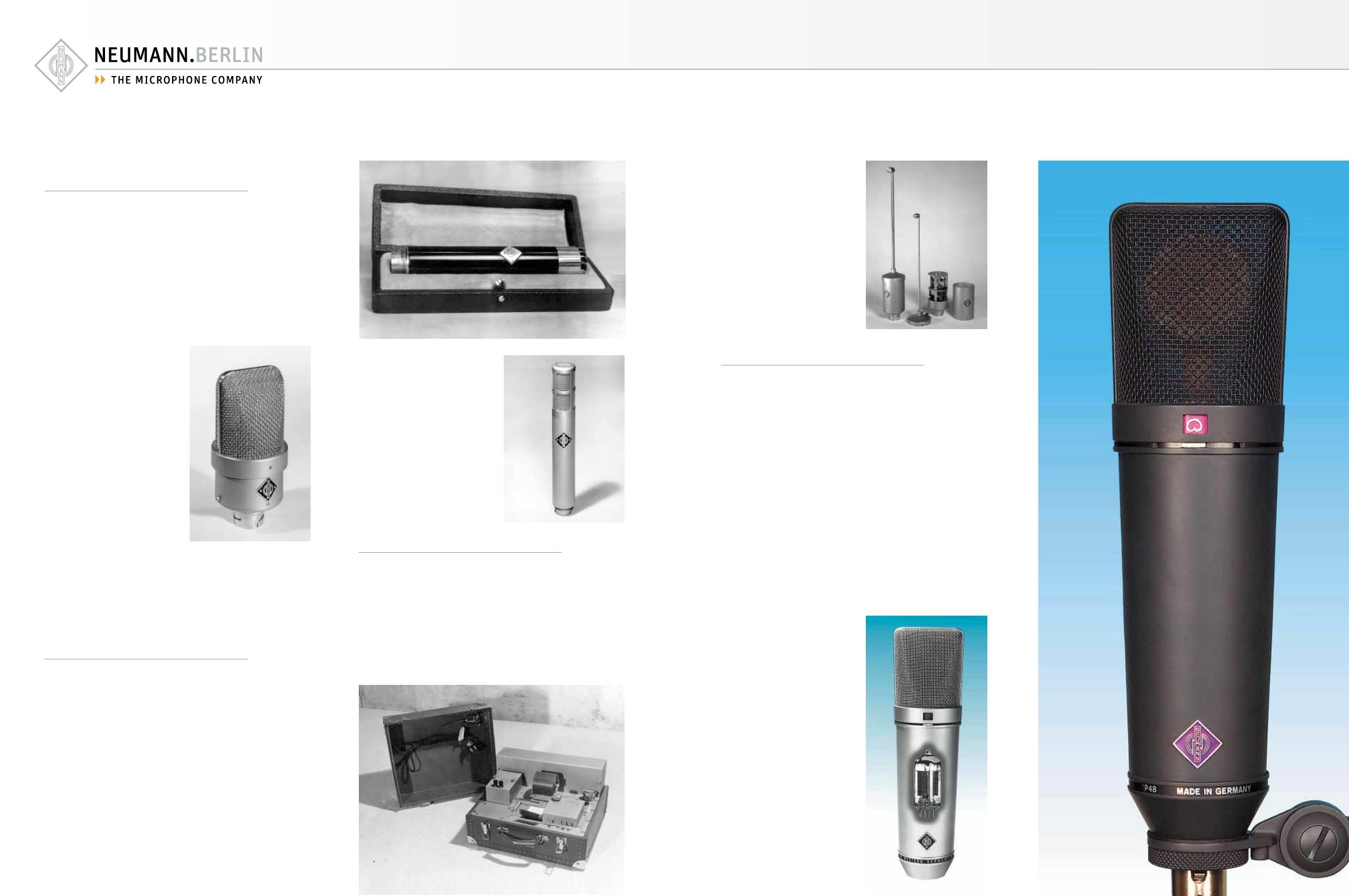
Neumann History
76
The First
Remote-Switchable Microphone
Other models appeared in 1949 and 1950, both
bearing some notable progress. In 1950 the
M 50 featured a pressure capsule embedded in
acrylic glass to give an outstanding omnidirec-
tional pattern. But more important was its pred-
ecessor, the M 49, which was the first micro-
phone that could be remote-switched.
Neumann’s work on the M 49 coincided with a
similar invention by an engineer called Gross-
kopf, of the Central Laborato-
ry of the Nordwestdeutscher
Rundfunk in Hamburg. Here,
one microphone diaphragm
was fixed in the opposite di-
rection to the centre electrode
while the other one received a
capsule bias which could be
varied via a potentiometer.
This made it possible to switch
the characteristic smoothly
from omnidirectional, via car-
dioid, to figure-of-eight.
But it was Neumann, who
somehow managed to acquire
the patent for this, that went
on to produce the first remote-
switchable microphone, the M 49. Soon there
were numerous versions being launched by his
competitors, all of course made under license
from Neumann.
New Demands Posed
by Television and Sterephony
In Europe during the ’50s the two most impor-
tant developments in broadcasting technology
were undoubtedly the upsurge of television and
the arrival of stereophony, both requiring their
own specialised microphones.
By 1953 Neumann was meeting the demands
of television companies for smaller models
with a selection of condenser microphones
only 21 mm in diameter choice of omnidirec-
tional or cardioid models were available, plus
a switchable model which combined omnidi-
rectional, cardioid and bi-directional charac-
teristics.
To record in stereo naturally called for two mi-
crophones placed in such a manner that their
time/amplitude response was coincident. The
ideal solution therefore was to
mount two capsules in one
housing.
In 1956 Neumann produced the
SM 2, which was to remain the
only stereo microphone in the
world for many years.
Measuring Technology
During the course of the next two and a half
decades the potential for realistic sound re-
production offered by stereophony generated
intensified research in the recording world. For
the laboratories one of the first breakthroughs
was the arrival, in 1934, of Neumann’s P 2,
the first factory produced logarithmic-display
level recorder. This became the standard meas-
uring equipment in acoustic
testing laboratories for many
years, notching up world-wide
sales in the process.
In this connection, one also
should not overlook the calibra-
tion microphones developed by
Neumann.
From Tubes to Transistors
The aforementioned miniature microphones of
the fifties and sixties were, of course, all tube
microphones. Considering the small diameter of
these microphones, this continues to amaze
many users even today. The tube used was usu-
ally the Telefunken AC 701 tube, which had been
developed especially for use in microphones. For
the time being, Neumann’s last tube-driven mi-
crophone circuit, developed in 1960, was des-
tined for use in the U 67 switchable large-mem-
brane microphone. It also marked another mile-
stone. This microphone model, which survives
today as the U 87 A, can rightfully be called one
of the world’s most well-known studio micro-
phones.
In the sixties, tubes used as amplifiers and im-
pedance converters were increasingly replaced
by transistors. Upon the market
launch of the field effect tran-
sistor, at the latest, condenser
microphone circuits proved to
be no exception. In 1965, Neu-
mann introduced the “KTM”
1965, his first microphone
with transistor circuitry. A short
time later, Neumann developed
the concept of “phantom pow-
er” with 48 V. Now it was no
longer necessary to have a sep-
arate power supply for each mi-
crophone. Instead, all micro-
phone inputs could be fed cen-
trally with 48 V. The special,
multi-core microphone cable
was dropped in favour of three-
core standard cable, The numer-
ous connector types were uni-
fied and have now been re-
placed world-wide by three-pin
XLR connectors.















